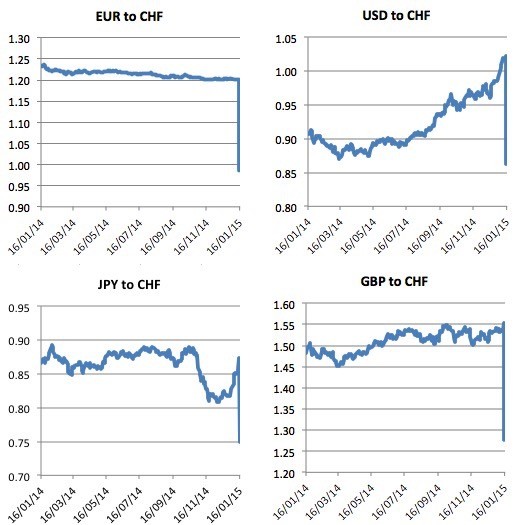
SNB Shocks the World and now the crisis is entering a new Phase
After the initial massive gap in CHF pairs, the CHF is now trading well off of its strongest levels of the day. SNB chief Jordan said in his postpartum press conference that the Swiss franc dramatically overshot and that he expected it to ultimately reflect the fundamentals of a soft Swiss economy with negative deposit rates. This statement acknowledges the huge dislocation in USD/CHF that has resulted from the SNB’s actions.
The Swiss central bank also announced a further reduction to an already
negative deposit rate. Swiss bank account holders will now be paying 0.75% for
the privilege of having funds on deposit in the Swiss banking system.
The move by the SNB created a violent 28% collapse in EUR/CHF. There was an equally violent collapse in USD/CHF.
The ECB has been explicitly devaluing the euro through their policies and policy guidance. Meanwhile, the Swiss National Bank has been persistently gobbling up euros in defense of their EUR/CHF exchange rate floor. That euro stockpile has been persistently losing value, and all evidence points to much larger losses ahead. With that, it appears most likely that the SNB decided to step out of the way of the downhill freight train, the euro.
For global markets, attention continues to be squarely on Europe. And today’s events highlight that point. Stocks, interest rates and currencies have been swinging around, driven primarily by fears that the deflationary problems in Europe are a deeper signal of weak global demand. But weak global demand isn’t a new problem. It has been a clear problem from the outset of the 7+ year global financial and economic crisis. That dynamic has been improving, not worsening. Europe, however, is facing deflationary pressures and no growth due to other factors, most importantly, while they should have been rolling out policies to promote growth in 2010, they further strangled growth by tightening the fiscal belt.
SNB decision tells us that the crisis is entering a new phase
Switzerland – home of the secret bank vaults, which house treasures stolen from people (particularly the Jewish victims) by the Nazis during WW2 and ill-gotten cash by capitalists who wish to evade scrutiny of prudential and tax authorities of their domiciled nations. Now it is the canary, which has just sung to tell us that all the hubris about Eurozone recovery cannot cover up the reality that the crisis is not yet over and requires root and branch reform to the policy ideology that exposes the floored design of the monetary union. The – Decision – last week (January 15, 2015) by the Swiss National Bank (SNB) to both break the peg of the Swiss franc to the euro and cut its interest rate on sight deposits to -0.75 per cent signals the surrender by that nation to the reality surrounding its borders. The interest rate decision was required after it decided to scrap the exchange rate peg, given that it didn’t want a credit crunch killing the domestic economy. The appreciation of the exchange rate, which has been held artificially low by the peg, will already undermine domestic spending. The SNB said its decision as reversing its previous “exceptional and temporary measure”, which “protected the Swiss economy from serious harm” as the exchange rate became overvalued. But the decision itself was rather extraordinary given it was seemingly so surprising for most and central bankers are meant to be cautious types

But this is a longer-term view (using monthly data) and I have expressed the currencies in reverse order in this graph so an appreciation is a fall in the graph. The reason for presenting the data in this way is because the SNB provides the raw data in two different forms and I was just saving myself time. But then, of course, once I had created the graphs I realized that typing these three lines took me more time than computing the reciprocal in Excel!
The arrow shows the appreciation that particularly against the USD but also the yen and the euro, which led the SNB to impose the peg on September 6, 2011. At the time, it was clearly a decision aimed to protect the export sector, which is the largest as a percentage of GDP in the world (around 73 per cent, compared say to South Korea (54 per cent), Germany (46 per cent), China (27 per cent), Japan (16 per cent) and the US (14 per cent).
SNB released a press
statement –
Swiss National Bank sets
minimum exchange rate at CHF 1.20 per euro – which said:
The current massive overvaluation of the Swiss franc poses an acute threat to the Swiss economy and carries the risk of a deflationary development … With immediate effect; it will no longer tolerate a EUR/CHF exchange rate below the minimum rate of CHF 1.20. The SNB will enforce this minimum rate with the utmost determination and is prepared to buy foreign currency in unlimited quantities.
That means it acknowledged its currency sovereignty and its capacity to create “unlimited quantities” of it to pursue its stated goals.
As the graphs show, the decision clearly stabilized the CHF against the euro and the other leading currencies.
The Danish bank today cut its deposit rate to minus 0.2 percent, matching a record low, from minus 0.05 percent and lowered its lending rate to a record 0.05 percent from 0.2 percent. While the bank can adjust rates at any time, it traditionally announces changes on Thursdays and mostly in connection with ECB moves.
Today’s cuts “underline the fact that the inflow has been pretty massive since they decided to move on a Monday,” said Arne Lohmann Rasmussen, head of fixed-income research at Danske Bank. “We should price in a probability of a new cut on Thursday, especially if the FX intervention continues.”
Source :- bloomberg.com ; forbes.com ; Investing.com


